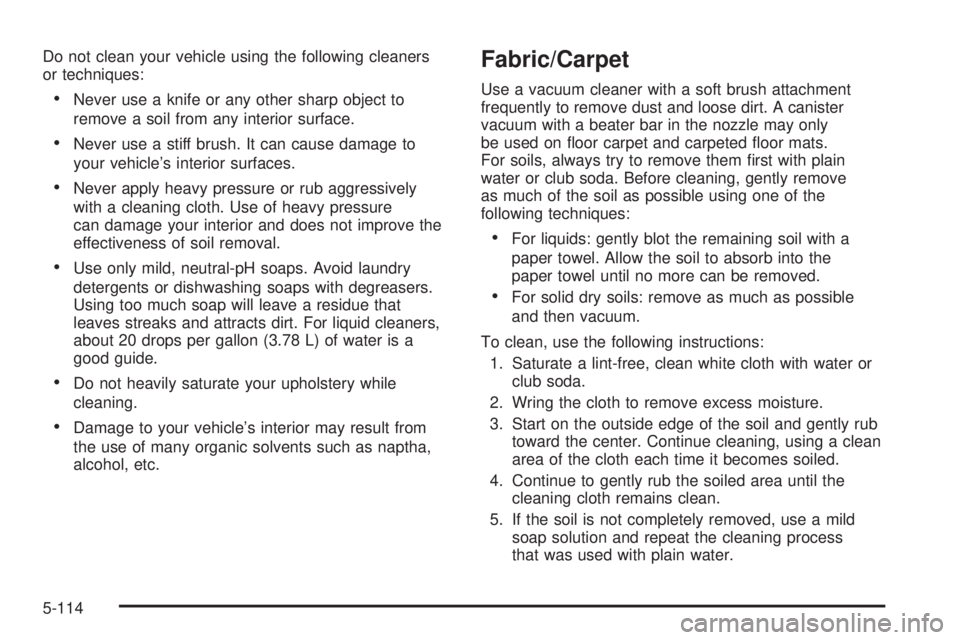2006 GMC SIERRA tow bar
[x] Cancel search: tow barPage 408 of 600

Auxiliary Battery
The auxiliary battery provision can be used to supply
electrical power to additional equipment that you
may choose to add, such as a slide-in camper.
If your vehicle has this
provision, this relay will be
located on the passenger’s
side of the vehicle, next
to the auxiliary battery.
When using this provision, connection should only be
made to the upper stud (A) of the relay. Do not make
connections to the lower stud (B) of the relay.
The auxiliary battery circuit is protected by a megafuse
located behind the auxiliary battery.
Be sure to follow the proper installation instructions that
are included with any electrical equipment that you install.Notice:Leaving electrical equipment on for
extended periods will drain the battery. Always turn
off electrical equipment when not in use and do not
use equipment that exceeds the maximum amperage
rating for the auxiliary battery provision.
Power Winches
If you wish to use a power winch on your vehicle, only
use it when your vehicle is stationary or anchored.
Trailer Recommendations
You must subtract your hitch loads from the CWR for your
vehicle. Weigh your vehicle with the trailer attached, so
that you won’t go over the GVWR or GAWR. If you are
using a weight-distributing hitch, weigh the vehicle
without the spring bars in place.
You’ll get the best performance if you spread out the
weight of your load the right way, and if you choose
the correct hitch and trailer brakes.
For more information, seeTowing a Trailer on
page 4-67.
4-96
Page 526 of 600

Do not clean your vehicle using the following cleaners
or techniques:
Never use a knife or any other sharp object to
remove a soil from any interior surface.
Never use a stiff brush. It can cause damage to
your vehicle’s interior surfaces.
Never apply heavy pressure or rub aggressively
with a cleaning cloth. Use of heavy pressure
can damage your interior and does not improve the
effectiveness of soil removal.
Use only mild, neutral-pH soaps. Avoid laundry
detergents or dishwashing soaps with degreasers.
Using too much soap will leave a residue that
leaves streaks and attracts dirt. For liquid cleaners,
about 20 drops per gallon (3.78 L) of water is a
good guide.
Do not heavily saturate your upholstery while
cleaning.
Damage to your vehicle’s interior may result from
the use of many organic solvents such as naptha,
alcohol, etc.
Fabric/Carpet
Use a vacuum cleaner with a soft brush attachment
frequently to remove dust and loose dirt. A canister
vacuum with a beater bar in the nozzle may only
be used on �oor carpet and carpeted �oor mats.
For soils, always try to remove them �rst with plain
water or club soda. Before cleaning, gently remove
as much of the soil as possible using one of the
following techniques:
For liquids: gently blot the remaining soil with a
paper towel. Allow the soil to absorb into the
paper towel until no more can be removed.
For solid dry soils: remove as much as possible
and then vacuum.
To clean, use the following instructions:
1. Saturate a lint-free, clean white cloth with water or
club soda.
2. Wring the cloth to remove excess moisture.
3. Start on the outside edge of the soil and gently rub
toward the center. Continue cleaning, using a clean
area of the cloth each time it becomes soiled.
4. Continue to gently rub the soiled area until the
cleaning cloth remains clean.
5. If the soil is not completely removed, use a mild
soap solution and repeat the cleaning process
that was used with plain water.
5-114
Page 594 of 600

Light (cont.)
Tow/Haul Mode...........................................3-50
Traction Off................................................3-43
Up-Shift.....................................................3-41
Lighting
Entry.........................................................3-19
Exit...........................................................3-19
Loading Your Vehicle.......................................4-48
Locking Rear Axle...........................................4-11
Lockout Protection..........................................2-13
Locks
Delayed Locking..........................................2-10
Door........................................................... 2-8
Lockout Protection.......................................2-13
Power Door.................................................. 2-9
Programmable Automatic Door Locks.............2-10
Rear Door Security Locks.............................2-13
Loss of Control...............................................4-15
Low Fuel Warning Light...................................3-51
Lumbar
Power Controls............................................. 1-4
M
Maintenance Schedule
Additional Required Services........................... 6-7
At Each Fuel Fill.........................................6-11
At Least Once a Month................................6-12
At Least Once a Year..................................6-12Maintenance Schedule (cont.)
At the First 100, 1,000 and 6,000 Miles
(160, 1 600 and 10 000km).......................6-11
Introduction.................................................. 6-2
Maintenance Footnotes.................................. 6-9
Maintenance Record....................................6-20
Maintenance Requirements............................. 6-2
Normal Maintenance Replacement Parts.........6-18
Owner Checks and Services.........................6-11
Recommended Fluids and Lubricants.............6-14
Scheduled Maintenance................................. 6-4
Using.......................................................... 6-3
Your Vehicle and the Environment................... 6-2
Malfunction Indicator Light................................3-46
Manual Seats................................................... 1-3
Manual Selectable Ride...................................4-10
Manual Transmission
Fluid..........................................................5-33
Operation...................................................2-34
Manual Windows............................................2-16
Memory Seat.................................................2-83
Message
DIC Warnings and Messages........................3-55
Mirrors
Automatic Dimming Rearview with Compass....2-63
Automatic Dimming Rearview with Compass
and Temperature Display...........................2-65
Automatic Dimming Rearview with OnStar
®
and Compass..........................................2-59
8
Page 597 of 600

Rearview Mirror, Automatic Dimming with
OnStar®and Compass.................................2-59
Rearview Mirror, Automatic Dimming with
OnStar
®, Compass and Temperature Display . . . 2-61
Rearview Mirrors.............................................2-59
Reclining Seatbacks.......................................... 1-6
Recommended Fluids and Lubricants.................6-14
Recovery Hooks.............................................4-47
Recreational Vehicle Towing.............................4-62
Remote Keyless Entry System............................ 2-4
Remote Keyless Entry System, Operation............ 2-5
Removing the Flat Tire and Installing the
Spare Tire..................................................5-96
Removing the Spare Tire and Tools...................5-92
Replacement Bulbs.........................................5-70
Reporting Safety Defects
Canadian Government..................................7-14
General Motors...........................................7-14
United States Government............................7-13
Restraint System Check
Checking the Restraint Systems....................1-87
Replacing Restraint System Parts
After a Crash..........................................1-88
Retained Accessory Power (RAP)......................2-23
Right Front Passenger Position, Safety Belts......1-25
Roadside
Assistance Program....................................... 7-6
Rocking Your Vehicle to Get it Out....................4-46
Routing, Engine Drive Belt...............................6-19
Running the Engine While Parked.....................2-58
S
Safety Belt
Reminder Light............................................3-34
Safety Belts
Care of....................................................5-116
Center Front Passenger Position....................1-25
Driver Position............................................1-16
How to Wear Safety Belts Properly................1-16
Questions and Answers About Safety Belts.....1-15
Rear Safety Belt Comfort Guides...................1-29
Rear Seat Passengers.................................1-26
Right Front Passenger Position......................1-25
Safety Belt Extender....................................1-30
Safety Belt Use During Pregnancy.................1-24
Safety Belts Are for Everyone.......................1-11
Safety Warnings and Symbols.............................. iii
Scheduled Maintenance..................................... 6-4
Seatback Latches............................................. 1-8
Seats
Head Restraints............................................ 1-7
Heated Seats............................................... 1-5
Manual........................................................ 1-3
Memory.....................................................2-83
Power Lumbar.............................................. 1-4
Power Seats................................................. 1-4
Rear Seat Operation...............................1-8, 1-9
Reclining Seatbacks...................................... 1-6
Seatback Latches.......................................... 1-8
Secondary Latch System................................5-105
11